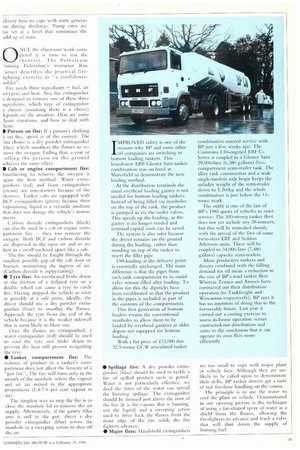O NCE the classroom work completed it is time to test
Page 33

If you've noticed an error in this article please click here to report it so we can fix it.
the theories. The Petroleum l'raining Federation's instructor Ron 7urner describes the practical fireighting exercise as "a confidencemilder".
Fire needs three ingredients — fuel, air oxygen) and heat. Any fire extinguisher s designed to remove one of these three ngredients; which type of extinguisher s chosen (assuming there is a choice) lepends on the situation. !fere are some :lassie situations, and how to deal with hem:
D Person on fire: If a person's clothing s on tire, speed is of the essence. The irst choice is a dry powder extinguisher ;blue) which smothers the flames to remove the oxygen. Failing that, a coat or "oiling the person on the ground schieves the same effect.
• Cab or engine compartment fire: Smothering to remove the oxygen is spin the best method. Water extinguishers (red) and loans extinguishers (cream) arc non-starters because of the electrics. Tanker cabs are equipped with BCF extinguishers (green) because their vapourising liquid is a versatile medium that does not damge the vehicle's instruments.
Carbon dioxide extinguishers (black) can also he used in a cab or engine compartment lire — they too remove the oxygen. Both BCF and carbon dioxide are dispersed in the open air and so are best in a small enclosed space like a cab.
The fire should be fought through the smallest possible gap of the cab door or bonnet, minimising the ingress of air. (Carbon dioxide is asphyxiating).
• Tyre fire: An overheated brake drum or the friction of a deflated tyre on a double wheel can cause a tyre to catch tire. Having stopped the vehicle as soon as possible at a safe point, ideally, the driver should use a dry powder extinguisher (blue) to smother the flames. Approach the tyre from the end of the vehicle because it is the weaker sidewall that is most likely to blow out.
Once the flames are extinguished, a water extinguisher (red) should be used to cool the tyre and brake drum to prevent the heat still present re-igniting the tyre.
• Tanker compartment fire: The volume of product in a tanker's compartment does not affect the ferocity of a
"pot tire". The fire will burn only in the mouth of the manhole where the vapour and air are mixed in the appropriate proportions (1.4-7.6 per cent vapour to air).
The simplest way to stop the tire is to close the manhole lid to remove the air supply. Alternatively, if the gantry filler arm is still in the pot, direct a dry powder extinguisher (blue) across the manhole in a sweeping action to shut off the air.
• Spillage fire: A dry powder extinguisher (blue) should be used to tackle a tire of spilled product such as petrol. Water is not particularly effective, indeed the force of the water can spread the burning spillage. The extinguisher should be focused just above the root of the tire (it is the vapour that is burning, not the liquid) and a sweeping action used to drive back the flames from the front edge of the fire while the fire fighters advance.
• Major fires: Hand-held extinguishers
are too small to cope with major plant or vehicle fires. Although they are unlikely to be called upon to demonstrate their skills, BP tanker drivers get a taste of real fire-hose handling on the course.
The principle is to use the water to cool the plant or vehicle. Demonstrated in our opening picture is the technique of using a fan-shaped spray of water as a shield from the flames, allowing the fire-fighters to advance and reach a valve that will shut down the supply of burning fuel.






















































